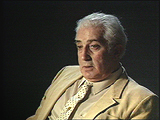

The gas chamber was also a hall just like this one, with two chutes, two, uh, like chimneys going all the way to the top, with perforated metal. Had holes about a quarter of an inch all around, all four corners, and it was two or three sheets of metal, one into the other with holes. That chute went all the way up to the roof, which was almost flat to the ground outside. That's where the SS men were standing as soon as the bunker was filled in, yeah wait a minute.... When they filled in the bunker with all the women they put the men in. And sometimes they had 20 or 30 extra people that they couldn't get in, so they always held back children. And when the bunker was already so filled they couldn't put no more people, no more...they made the kids crawl on the top of the heads, all the way in there, just kept on pushing them in, to fill them all in. When the door was slammed behind them, was a thick door, was about six inches thick. I built it myself and I know what it's like: three bolts, three iron bars were across. The bars were laid over and then screwed tight. The men, the SS men were standing outside with a Red Cross wagon and they had the gas can...cans in the truck, in the...in the ambulance. He put a mask on, had to put a mask on, tore the lid off of the gas...of the...of the, um, the gas canister, threw it down the chute, through the chimney into the gas chamber. The crematorium two and...and three had two gas chutes. And as soon as he threw the gas in he slammed the lid shut, so the gas wouldn't escape. And all you could hear is one loud sound, "Shema..." [the Jewish declaration of faith] and that was all. And that took about five to ten minutes. In the door they had a little peephole with four or five layers of glass in between, and it was with bars so nobody could break the glass through. And when they turned on the light into the...in the...in the bunker, you could see whether the people were already dead or not.
The gas chamber was also a hall just like this one, with two chutes, two, uh, like chimneys going all the way to the top, with perforated metal. Had holes about a quarter of an inch all around, all four corners, and it was two or three sheets of metal, one into the other with holes. That chute went all the way up to the roof, which was almost flat to the ground outside. That's where the SS men were standing as soon as the bunker was filled in, yeah wait a minute.... When they filled in the bunker with all the women they put the men in. And sometimes they had 20 or 30 extra people that they couldn't get in, so they always held back children. And when the bunker was already so filled they couldn't put no more people, no more...they made the kids crawl on the top of the heads, all the way in there, just kept on pushing them in, to fill them all in. When the door was slammed behind them, was a thick door, was about six inches thick. I built it myself and I know what it's like: three bolts, three iron bars were across. The bars were laid over and then screwed tight. The men, the SS men were standing outside with a Red Cross wagon and they had the gas can...cans in the truck, in the...in the ambulance. He put a mask on, had to put a mask on, tore the lid off of the gas...of the...of the, um, the gas canister, threw it down the chute, through the chimney into the gas chamber. The crematorium two and...and three had two gas chutes. And as soon as he threw the gas in he slammed the lid shut, so the gas wouldn't escape. And all you could hear is one loud sound, "Shema..." [the Jewish declaration of faith] and that was all. And that took about five to ten minutes. In the door they had a little peephole with four or five layers of glass in between, and it was with bars so nobody could break the glass through. And when they turned on the light into the...in the...in the bunker, you could see whether the people were already dead or not.
Describes gas chambers in Auschwitz
[Interview: 1991]
The Germans invaded Poland in September 1939. When Makow was occupied, Sam fled to Soviet territory. He returned to Makow for provisions, but was forced to remain in the ghetto. In 1942, he was deported to Auschwitz. As the Soviet army advanced in 1944, Sam and other prisoners were sent to camps in Germany. The inmates were put on a death march early in 1945. American forces liberated Sam after he escaped during a bombing raid.
— Jewish Community Federation of Richmond
"Final Solution": Overview »
Auschwitz »
Auschwitz (Abridged Article) »
Final Solution (Abridged Article) »
Gassing Operations »
Gassing Operations (Abridged Article) »
Killing Centers (Abridged Article) »
Killing Centers: An Overview »